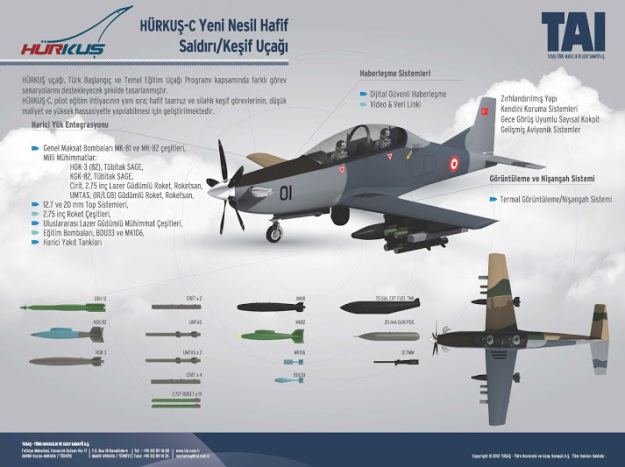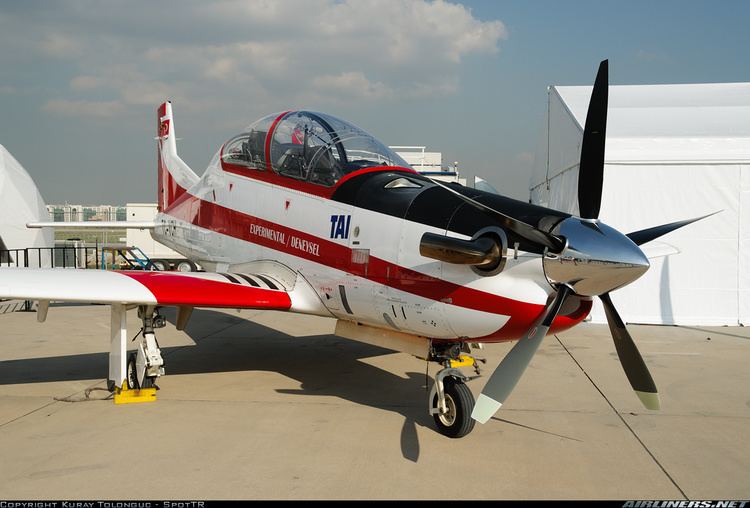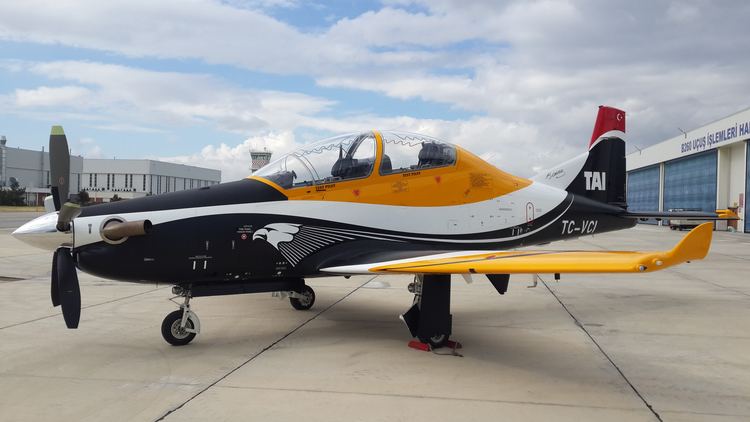Top speed 574 km/h Length 11 m | Wingspan 9.96 m Number built 4 prototypes First flight 29 August 2013 | |
 | ||
Manufacturer | ||
Tai h rku free bird basic trainer and counter insurgency aircraft
The TAI Hürkuş (Free Bird) is a tandem two-seat, low-wing, single-engine, turboprop aircraft being developed by Turkish Aerospace Industries (TAI) as a new basic trainer and ground attack aircraft for the Turkish Armed Forces.
Contents
- Tai h rku free bird basic trainer and counter insurgency aircraft
- Tai h rku 30 08 2015 amateur close zoomed tracking
- Design and development
- Variants
- Specifications Hrku
- References
The aircraft is named after Vecihi Hürkuş, a World War I and Turkish Independence War veteran pilot, a Turkish aviation pioneer and the first Turkish airplane manufacturer.

Tai h rku 30 08 2015 amateur close zoomed tracking
Design and development

The TAI Hürkuş Development Program started with an agreement signed between Turkish Undersecretariat for Defense Industries (Savunma Sanayii Müsteşarlığı (SSM)) and TAI in March 2006. Under the agreement the company will design, manufacture and complete the civil certification the aircraft to European Aviation Safety Agency CS 23 standards.

By June 2012 the Hürkuş program had consumed one million man-hours with the work of 140 engineers. About a quarter of the Turkish engineers who have worked on Hürkuş are female, as well as two of the three project heads.

The Hürkuş will be equipped for day and night flying as well as basic pilot training, instrument flying, navigation training, weapons and formation training. The aircraft will have good visibility from both cockpits with a 50 degree down-view angle from the rear cockpit, cabin pressurization (nominal 4.16 psid), Martin-Baker Mk T-16 N 0/0 ejection seats, an onboard oxygen generation system (OBOGS), an Environmental Control System (Vapor Cycle Cooling), an anti-G system, high shock absorbing landing gear for training missions, and Hands On Throttle and Stick (HOTAS). Microtecnica of Turin, Italy has been selected to provide the aircraft's environmental control system. The Hürkuş has been designed for a 35-year service life.
The Hürkuş development program has been subject to delays. In 2007 it was forecast that the first prototype would fly in late-2009 with first delivery, upon completion of the certification process, forecast for 2011. On 27 June 2012, the Hürkuş was officially rolled out at a ceremony held at TAI's Kazan premises. The forecast date for the first flight was then delayed until later in 2012 and actually occurred on 29 August 2013 when the aircraft flew from the Ankara Akıncı Air Base on a 33-minute flight.
The Turkish government has indicated that the aircraft is expected to attract export sales, possibly from Middle Eastern countries, African countries or countries with limited air force budgets. According to a news report from CNN Türk, Australia and Sweden are interested in the aircraft.
In 2016, the Hürkuş-A trainer aircraft was awarded a CS-23 Validation Type Certificate by the European Aviation Safety Agency (EASA) and an Aircraft Type Certificate by the Turkish Directorate General of Civil Aviation (DGCA)
The Turkish Army is has an order for 15 Hürkuş-B aircraft plus an option for 40 more. Deliveries are scheduled for mid 2017
In February 2017, photos were released by the Turkish MoD showing the prototype for armed version, the Hürkuş-C.
Variants
Specifications (Hürkuş)
Data from TAI and Airforce Technology
General characteristics
Performance
Armament
Avionics
